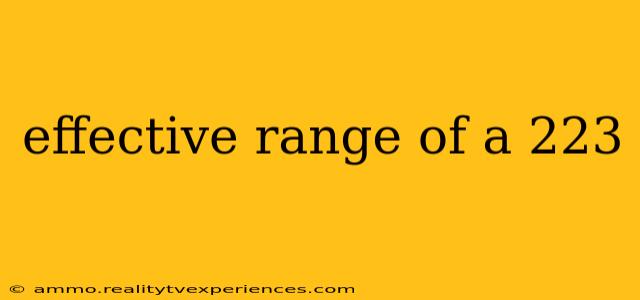The effective range of a .223 Remington cartridge is a complex question, depending heavily on several factors beyond just the firearm itself. While some sources might offer a single number, understanding the nuances is crucial for responsible firearm handling and target practice. This guide delves into the specifics, separating accuracy from lethality and considering the variables impacting effective range.
Factors Affecting .223 Effective Range
Several key variables significantly influence the practical effective range of a .223:
-
Ammunition: Different .223 ammunition types exhibit varying ballistic characteristics. Heavier bullets generally have a flatter trajectory and maintain velocity better over distance, extending effective range. Conversely, lighter bullets drop more quickly and lose velocity faster. The bullet's design (e.g., full metal jacket, hollow point) also impacts its flight path and terminal performance.
-
Firearm: The rifle's barrel length, twist rate, and overall quality directly affect accuracy and velocity. Longer barrels generally yield higher velocities, improving range. The twist rate dictates how the bullet stabilizes in flight, influencing accuracy at longer ranges.
-
Shooter Skill: Even with ideal ammunition and a high-quality rifle, shooter skill is paramount. Proper sighting, trigger control, and breathing techniques significantly impact accuracy at all distances. A skilled shooter can achieve greater precision at longer ranges than a novice.
-
Environmental Conditions: Wind, temperature, and humidity all affect bullet trajectory. Strong winds can cause significant drift, rendering shots inaccurate at longer distances. Temperature changes can also subtly alter bullet velocity.
-
Target Size and Type: The size and nature of the target greatly influence effective range. Hitting a small, distant target demands much greater accuracy than engaging a larger, closer one.
Accuracy vs. Lethality: Defining Effective Range
We must distinguish between the accurate range and the lethal range of a .223.
Accurate Range:
This refers to the distance at which a shooter can consistently place shots within a desired group size on a target. For many .223 rifles, this might realistically extend to 300-500 yards for experienced shooters with appropriate ammunition and equipment. Beyond that, environmental factors and bullet drop become increasingly significant, making precise shot placement challenging.
Lethal Range:
Lethal range refers to the distance at which the round retains enough energy to reliably incapacitate or kill a target. This is significantly shorter than the accurate range. While a .223 round might travel much further, its energy decreases substantially with distance, reducing its stopping power. Beyond 300-400 yards, consistent lethality becomes unpredictable, even with suitable ammunition. Many experts consider the practical lethal range to be considerably less, particularly considering ethical hunting practices or self-defense scenarios.
Conclusion: A Responsible Perspective
The effective range of a .223 isn't a single, definitive number. It’s a range of distances heavily dependent on the interplay of numerous factors. While a .223 round can travel much further than its effective range, responsible firearm owners should understand the limitations of the cartridge and their own skill levels to ensure safe and ethical use. Always practice at a safe shooting range, use appropriate safety gear, and prioritize accuracy and ethical considerations over maximizing distance.

